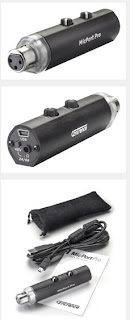
Two years ago I posted on this blog about a nifty little unit I saw coming onto the US market. Called the MicPort Pro, it is a small tube which allows you to connect an analogue microphone to the USB input of a laptop or PC (Mac or Windows). I still haven't managed to improve on it.
You may think that you can do that already with a Canon (XLR) to 3.5 mm cable plugged into the microphone input of your laptop. But, having used this device intensively for two years, the audio quality you get out of the external converter is vastly superior to the sound card in most PC's - even the Mac. The secret lies in the MicPort's USB microphone high quality preamp featuring 24-bit/96kHz performance. There is also a 48V phantom power inside the MicPort which allows me to connect an analogue Rode NT2 broadcast microphone (condenser) - and that wouldn't work if you just plug into the laptop. The results then are just superb, either for voiceover work or podcasting. The unit gets its power through the USB cable, so you need that connected for the microphone to get its power (if you're using phantom) and for the headphone monitor to work as well. Headphone output has no delay in it - essential if you are monitoring yourself speaking live.
The great thing about the unit is that it doesn't need special drivers for use on Windows 7 and Mac OS X™ audio applications. There's a little white LED under the Canon connector which lights when the computer "sees" the device. It really is plug and play (or more accurately - plug and record). MicPort Pro ships with a 2 metre long USB cable and a carrying pouch.
Users can download free software tools for recording and mixing from the CEntrance website. These are lite versions of professional software. Personally, I used my own software for mixing - Garageband or the Voice Over option in Final Cut Pro.
I found this unit to be ideal for a remote reporter-studio location in West Africa. That's because you simply plug this unit into the laptop and select it as the microphone source in Skype. Then you get (near-enough) studio quality contributions to live discussion programmes, providing the ADSL bandwidth is sufficient (and stable). So, as well as recording for a podcast, this unit is useful for live contributions.
The chassis is made of rugged aluminium to stand wear and tear - and being dropped a few times, and the casing will keep out the dirt and dust you find on travels. I still think it would be interesting if they incorporated a 4 GHz flash card inside the same metal housing (or slightly larger)- making it an instant competitor to the hopelessly outdated HHB Flashmic.
Stereo and multi-track recording is also possible with MicPort Pro thanks to the CEntrance Universal Driver™ that aggregates input from multiple MicPort Pro units with a very low latency (delay due to conversion) of less than 6 milliseconds. This means if you own several of these units, you can link them together on the same laptop, assuming you have enough USB ports.
So what about the cost? MicPort Pro prices, as of August 2010, show the average in the US is $149.95. I find the European dealers (in Germany for instance) are considerably more expensive at €165.41 including VAT (that's US$209 at mid 2010 exchange rates, down 50 bucks on the exchange rate two years ago, but still) and £109.99 in the UK (also including VAT). That said, I have no hesitation in recommending it.
More details on the recently upgraded CEntrance website which shows U.S. and international resellers.